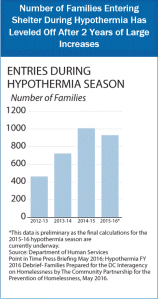New family homelessness data reveals good news in the District’s struggle to combat family homelessness, but growing rents and stagnant income still leave far too many residents homeless. Moreover, funding in the just-adopted budget for the coming year will not be enough to keep up. Making more progress will require increased funding for homeless services, but also require the District to make
giant leaps to create more affordable housing.
Family homelessness worsened dramatically in recent years, but there are signs it may be leveling off now. The number of families entering shelter this past winter — about 930 — was 80 fewer than the year before, after more than doubling in the two years before that. And the number of families seeking shelter each month decreased this past hypothermia season, from 177 in November to 66 in March.
This is likely the result of improvements the District has implemented over the past months:
Doing More to Keep Families Out of Shelter: Last fall, the District launched a new homelessness prevention program, recommended by DCFPI and its allies, modeled after successful programs in New York City and Massachusetts. Over 1,000 families have gotten help, and 90 percent stayed out of shelter. With just $1 million, the District helped 900 families avoid shelter. With the average cost of getting out of shelter roughly $50,000, this is not only keeping families stable, it is saving the District millions. The fiscal year 2017 budget includes an increase of $1 million so about 400 more families can be served.
Sheltering Families When They Need It: This past summer, the District began taking families into shelter year-round, rather than only during hypothermia season when residents have a legal right to shelter. This means the city can help families regain stability more quickly, in addition to making sure families stay out of dangerous situations, like living with an abuser. It also improves the performance of the shelter system. When shelter is available only in the winter, the system is overwhelmed at the start of hypothermia season.
DC Has Increased the Pace of Helping Families Leave Shelter: Over the past year, the number of families leaving shelter, usually for temporary housing, increased by more than one-fourth. This is important, because family well-being deteriorates more the longer they stay in shelter. Moving families out of shelter faster also helps the District accommodate new families needing shelter.
While the District’s leaders deserve credit for their progress on homeless services, the real solution requires large new investments to create affordable housing. The FY 2017 budget includes a $100 million investment to renovate or construct roughly 1,000 affordable homes. But one recent study concluded that DC needs 20,000 affordable homes for very low-income households. Homelessness is the extreme manifestation of the challenges faced by thousands of DC residents struggling to cope with the rising costs of living. We cannot succeed at keeping residents from becoming homeless, or help them leave shelter once they become homeless, without more low-cost housing options.
Kate Coventry is a DCFPI Policy Analyst and voting member of the District Interagency Council on Homelessness.
To print a copy of today’s blog, click here.
